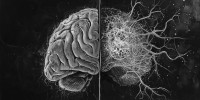
Unlocking the Brain: Spatial Multi-Omics Mapping
Today we approach the mysteries of the human brain with cutting-edge spatial multi-omics technologies! Discover how groundbreaking research is mapping the hippocampus at an unprecedented molecular level, providing new insights into brain function and the mechanisms behind depressive disorders.
Exploring the Human Brain: A New Frontier in Spatial Multi-Omics
The scientific community is abuzz with the potential of spatial multi-omics technologies, especially their application in understanding the intricacies of the human brain. This new frontier offers unprecedented insights into cellular interactions and molecular landscapes within brain tissues.
A recent dissertation by Graham Su at Yale University has made significant strides in this area, focusing on the hippocampus—a critical region involved in memory and emotions.
At a Glance
Project Overview: High-resolution spatial proteomics, transcriptomics, and epigenomics of the human hippocampus.
Techniques Used: Multiplexed fluorescence image-based spatial proteomics, Deterministic Barcoding in Tissue for spatial Omics sequencing (DBiT-seq).
Applications: Mapping normal and diseased (Major Depressive Disorder) hippocampal regions.
The Importance of Spatial Multi-Omics
With the advent of next-generation DNA sequencing, the omics revolution has enabled researchers to interrogate biomolecular assays at the single-cell level. However, a significant limitation has been the loss of spatial and phenotypic information when cells are dissociated for analysis.
This is particularly problematic for studying complex tissues like the brain, where cellular interactions and specific locations are crucial for understanding function and pathology.
Multiplexed Fluorescence Image-Based Spatial Proteomics
To address this challenge, Su's project first incorporated multiplexed fluorescence image-based spatial proteomics using a platform called Co-detection by indexing (CODEX). This technique offers single-cell resolution, allowing for the targeting of a large panel of protein markers and capturing extensive regions up to entire hippocampal cross-sections.
This approach enabled the precise description of major cell types in each sublayer of the hippocampus in nine neurotypical patient samples.
Spatial Omics Sequencing with DBiT-seq
The second phase of the project utilized the DBiT-seq platform to map the transcriptomic and chromatin accessibility landscape of the dentate gyrus region in the human hippocampus.
By introducing dual barcodes through orthogonal parallel channels, the technique appends a matrix of barcodes referencing the location to the transcriptome or genome. This method was optimized for brain tissues, culminating in a mapped omics atlas based on six neurotypical postmortem human hippocampi.
Application to Major Depressive Disorder
Leveraging the multi-omics atlas of the human hippocampus, the final phase of Su's project examined the molecular landscape within a clinical cohort of major depressive disorder (MDD) patient brains.
Spatial proteomics, transcriptomics, and epigenomics analyses were performed on MDD hippocampi, revealing cellular and functional changes that may play pivotal roles in the pathophysiology of the disease.
Conclusion and Future Directions
Su's groundbreaking work has not only implemented the spatial Omics platform DBiT-seq on brain-related tissue but also developed a spatial atlas for the human hippocampus in both healthy and MDD patient brains.
Su summarizes:
 These studies provide a large resource for not only furthering our understanding of the human hippocampus and dentate gyrus at a molecular level, but also the potential for new avenues in studying many different biological questions such as the mechanisms behind MDD.
These studies provide a large resource for not only furthering our understanding of the human hippocampus and dentate gyrus at a molecular level, but also the potential for new avenues in studying many different biological questions such as the mechanisms behind MDD.
Final Thoughts
The potential applications of spatial multi-omics in neuroscience are vast and promising. This pioneering work in mapping the human hippocampus opens up new pathways for understanding complex brain functions and diseases. As technology continues to advance, we can expect even more detailed and informative spatial maps, offering deeper insights into the brain's molecular and cellular architecture.